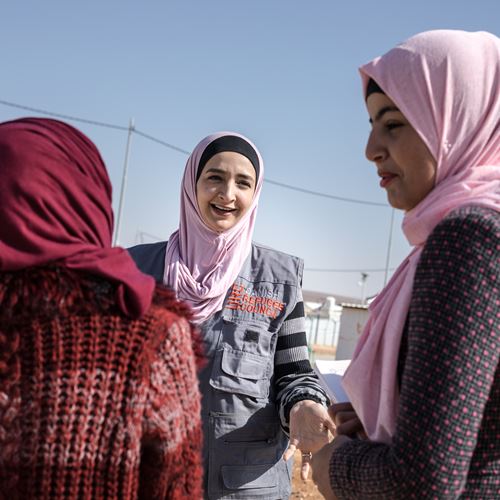
Working with local organizations to develop a Theory of Change for long-term gender transformation and economic empowerment for women
The second year of the GBVI Programme sees as the main outcome the creation of a Theory of Change (ToC) for each local anchor group.

Year 2 of the GBVI programme
This programme aims to generate evidence on integrated economic recovery and gender-based violence programming for GBV survivors, recognizing that gender inequality and economic exclusion are part of the root causes for GBV, particularly in conflict-affected displacement contexts. Integragating gender-based violence and economic recovery outcomes leading to gender-transformative change is therefore key.
Each country participating in the project has established a local anchor group consisting of key local stakeholders working in the areas of GBV and Economic Recovery.
In Year 2 of the project, the Local Anchor Groups have been developing localized theory of change (ToC) models for integrated GBV and Economic Recovery Programme that will be piloted in year 3. A Theory of Change is, according to the Center for Theory of Change’s definition, “a comprehensive description and illustration of how and why a desired change is expected to happen in a particular context”. Like any logic model, a ToC can be beneficial to help organize the resources, activities, outputs, and outcomes of a project, as well as communicate the project goals and process to others. For the Local Anchor Groups, it meant developing a plan for how to achieve the desired change through a specific set of activities and contextualized interventions.
To support the Local Anchor Groups to establish a theory of change, DRC and Womens Refugee Commission developed a global ToC playbook with step-by-step exercises that can guide organizations that want to develop an integrated theory of change.
The first step for each LAG in developing the ToC was to undertake a Gender and Market Assessment (GMA). This was done with support from expert consultants and ensured locally anchored evidence informed the design of the Toc GBV-EcRec program model. Specifically, the GMA provided details about barriers and how to improve accessibility to and participation of refugee and host community women survivors of GBV and women and girls at risk of GBV to market systems and livelihoods.
Working through the exercises of the global ToC playbook and using the findings from the Gender and Market Assessments, the Local Anchor Group in each country came together in 2-day workshops to develop localized Theory of Change models.
Developing a Theory of Change in Jordan
In April this year, the Local Anchor Group in Jordan with the support of DRC and WRC, came together for a 2-day workshop and developed a localized Theory of Change model for integrated Gender-Based Violence and Economic Recovery. The first step of the workshop was to develop a problem statement, informed by the findings of the gender and market assessment.
Jordan has the lowest rate of women’s economic participation of any country not at war. This is due to many different factors, including discriminatory social norms, attitudes, behaviours, and social systems that enforce gender inequality. The Gender and Market Assessment showed that refugee women face additional barriers, such as limited access to employment, healthcare, and educational opportunities. Consequently, refugee women are also at higher risk of sexual exploitation and abuse, forced and early marriage, and human trafficking. While the Jordanian government has taken steps to address GBV, including passing laws criminalizing domestic violence and establishing a national referral system for survivors of violence (UN Women, 2022), there is still a need for increased awareness and prevention efforts to address GBV in the country.
Based on this the Local Anchor Group came up with the following “GBV against refugee and vulnerable Jordanian women and girls in widespread in Jordan and normalized through traditional gender norms, which prevent women and girls from participating equally in decision-making and the labor market”.
Considering the challenges of the context in Jordan and the fixed time frame of the project, it proved difficult for the LAG to come up with a realistic long-term goal for the ToC, but the Local Anchor Group came up with the following: “Exposure to all forms of GBV against women and girls in Jordan is reduced and they are empowered to enjoy their rights and active and equal participation in their communities within a safe environment”.
Developing an integrated ToC model requires specific skills and knowledge from the two sectors, and since most LAG members had mainly experience in GBV, and less in economic recovery and MEAL this presents a challenge for the Local Anchor Group in Jordan.n Year 3 DRC will continue to support the Local Anchor Groups with capacity strengthening and to pilot the theory of change, and specifically work closely with Arab Women Organization of Jordan (AWO), a Jordanian local women’s rights organization established in 1970, who’s vision is to work for societal development through empowering Arab women and raising awareness on the necessity of engaging women as equal partners.
We will keep you updated with the future steps that DRC and WRC will take with AWO and the rest of the LAG members.


Women's Refugee Commission
